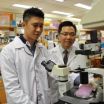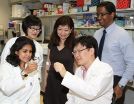(Press-News.org) Sieve elements are a key component of phloem, the conductive tissue through which plants transport carbohydrates and a wide range of signalling molecules. Elongated cylindrical cells are capped at one end by a sieve plate and arranged end-to-end to form sieve tubes which in turn form a network throughout a plant's body.
"Sieve elements are very special cells which play an important role in carbon sequestration, yet so far very little has been known about their differentiation," says Professor Ykä Helariutta from the Institute of Biotechnology, University of Helsinki, Finland. "We've identified several genes regulating the process and characterized it with unprecedented precision."
The results of the collaboration between the labs of Professor Ykä Helariutta and principal investigator Eija Jokitalo are published in a pair of papers appearing in Science and Nature Communications.
"Understanding how the phloem network develops is a significant aspect of plant development and could have important applications in biotechnology and synthetic biology," describes Helariutta.
Programmed nuclear degradation during phloem development
Sieve elements lose their nucleus during the course of normal development. In the first paper, the team described how that happens and identified several genetic factors controlling the process. They used serial block-face scanning electron microscopy to reconstruct a 3D model of developing sieve elements from ultra-thin sections, enabling them to track enucleation of these cells. The nucleus first deforms from a smooth sphere to a crumpled structure, before shrinking and loosing its contents into the cytoplasm, where they are degraded. This is coupled with the degradation of some organelles and shape changes of others.
The researchers identified two transcription factors, NAC045 and NAC086, which are expressed in sieve element cells before enucleation. Plants lacking both genes have defective sieve element formation and die at the seedling stage. Serial block-face scanning electron microscopy showed that sieve elements in the double mutant do not undergo enucleation. Furthermore, by expressing NAC45 in cells where it isn't normally found, the researchers showed that it is sufficient to start the degradation of the nucleus and cytoplasm.
The researchers also identified a family of genes, dubbed NEN1-4, which act downstream of NAC045 and NAC086. Although the enucleation process starts in plants with mutations in these genes, it doesn't complete properly.
Control of choline transport essential in phloem
A genetic screen identified the CHER1 gene, which encodes a choline transporter, as a crucial player in phloem development. In mutant plants, a fluorescent marker transported through the phloem failed to unload in the root tip, demonstrating defects in phloem transport. Further analysis revealed that the phloem strands are not continuous in the cher1 mutant, which also has short roots, abnormal roots hairs, and changes in the arrangement of the water-conducting xylem tissues.
CHER1 accumulates at one end of sieve element cells, collecting at the centre of the forming sieve plate. Examination with serial block-face scanning electron microscopy showed that mutant plants have smaller sieve plates with fewer, structurally-altered pores, inhibiting long-distance transport via the phloem. "Control of choline transport is essential to form continuously connected phloem with proper sieve plates, but we still have to uncover the exact cellular processes involved," says Helariutta.
INFORMATION:
Another article on the subject: CHOLINE TRANSPORTER-LIKE1 is required for sieve plate development to mediate long-distance cell-to-cell communication. Nature Communications 5, article nr 4276, 10 July 2014. http://www.nature.com/ncomms/2014/140710/ncomms5276/full/ncomms5276.html
Developmental regulation of important plant phloem components discovered
2014-08-01
ELSE PRESS RELEASES FROM THIS DATE:
Plastic surgeons or nurses: Who are the better injectors?
2014-08-01
In recent years, minimally invasive aesthetic injectable procedures have grown in popularity as more and more men and women are seeking age-defying treatments. As Botulinum toxin – generally known as BOTOX® – use has increased, a growing number of nonaesthetic health professionals have emerged to perform procedures utilizing this and other injectables. Kevin Small, MD and Henry M. Spinelli, MD from the Division of Plastic Surgery Presbyterian Hospital in New York and Kathleen M. Kelly, MD from Columbia University in New York have assessed the capability of various providers ...
'Active' surfaces control what's on them
2014-08-01
CAMBRIDGE, Mass-- Researchers at MIT and in Saudi Arabia have developed a new way of making surfaces that can actively control how fluids or particles move across them. The work might enable new kinds of biomedical or microfluidic devices, or solar panels that could automatically clean themselves of dust and grit.
"Most surfaces are passive," says Kripa Varanasi, an associate professor of mechanical engineering at MIT, and senior author of a paper describing the new system in the journal Applied Physics Letters. "They rely on gravity, or other forces, to move fluids or ...
'Wetting' a battery's appetite for renewable energy storage
2014-08-01
RICHLAND, Wash. – Sun, wind and other renewable energy sources could make up a larger portion of the electricity America consumes if better batteries could be built to store the intermittent energy for cloudy, windless days. Now a new material could allow more utilities to store large amounts of renewable energy and make the nation's power system more reliable and resilient.
A paper published today in Nature Communications describes an electrode made of a liquid metal alloy that enables sodium-beta batteries to operate at significantly lower temperatures. The new electrode ...
NUS study shows effectiveness of common anti-malarial drug in controlling asthma
2014-08-01
Asthmatic patients may soon have a more effective way to control the condition, thanks to a new pharmacological discovery by researchers from the National University of Singapore (NUS).
The team, led by Associate Professor Fred Wong from the Department of Pharmacology at the NUS Yong Loo Lin School of Medicine, together with Dr Eugene Ho Wanxing, a recent PhD graduate from the Saw Swee Hock School of Public Health at NUS, discovered that artesunate, a common herbal-based anti-malarial drug, can be used to control asthma, with better treatment outcomes than other drugs ...
Preterm children do not have an increased risk for dyscalculia
2014-08-01
Preterm children do not suffer from dyscalculia more often than healthy full term children. Dr Julia Jäkel, a developmental psychologist from Bochum, and her colleague Prof Dr Dieter Wolke from the University of Warwick, UK proved this thesis to be true in their analyses – thus refuting previous scientific studies. Unlike other studies, the researchers took the children's IQ into consideration.
Dyscalculia in preterm children often impossible to diagnose
Preterm children often have cognitive deficits; they find solving complex tasks particularly difficult. However, ...
Scientists solve 2000-year-old mystery of the binding media in China's polychrome Terracotta Army
2014-08-01
Even as he conquered rival kingdoms to create the first united Chinese empire in 221 B.C., China's First Emperor Qin Shihuang ordered the building of a glorious underground palace complex, mirroring his imperial capital near present-day Xi'an, that would last for an eternity.
To protect his underworld palaces, the First Emperor issued instructions that his imperial guard be replicated, down to the finest details, in red-brown terracotta clay, poised to do battle. Thousands of these imperial guards were initially discovered in 1974; some contained patches of pigment that ...
Taking the guesswork out of cancer therapy
2014-08-01
Researchers and doctors at the Institute of Bioengineering and Nanotechnology (IBN), Singapore General Hospital (SGH) and National Cancer Centre Singapore (NCCS) have co-developed the first molecular test kit that can predict treatment and survival outcomes in kidney cancer patients. This breakthrough was recently reported in European Urology, the world's top urology journal.
According to IBN Executive Director Professor Jackie Y. Ying, "By combining our expertise in molecular diagnostics and cancer research, we have developed the first genetic test to help doctors prescribe ...
Georgia Tech jailbreaks iOS 7.1.2
2014-08-01
Security researchers at the Georgia Tech Information Security Center (GTISC) have discovered a way to jailbreak current generation Apple iOS devices (e.g., iPhones and iPads) running the latest iOS software.
The jailbreak, which enables circumvention of Apple's closed platform, was discovered by analyzing previously patched vulnerabilities with incomplete fixes.
It shows that quick workarounds mitigating only a subset of a multi-step attack leave these devices vulnerable to exploitation. Patching all vulnerabilities for a modern, complex software system (i.e., Windows ...
Symbiotic survival
2014-08-01
Boulder, Colo., USA – One of the most diverse families in the ocean today -- marine bivalve mollusks known as Lucinidae (or lucinids) -- originated more than 400 million years ago in the Silurian period, with adaptations and life habits like those of its modern members. This Geology study by Steven Stanley of the University of Hawaii, published online on 25 July 2014, tracks the remarkable evolutionary expansion of the lucinids through significant symbiotic relationships.
At is origin, the Lucinidae family remained at very low diversity until the rise of mangroves and ...
Companion planets can increase old worlds' chance at life
2014-08-01
Having a companion in old age is good for people — and, it turns out, might extend the chance for life on certain Earth-sized planets in the cosmos as well.
Planets cool as they age. Over time their molten cores solidify and inner heat-generating activity dwindles, becoming less able to keep the world habitable by regulating carbon dioxide to prevent runaway heating or cooling.
But astronomers at the University of Washington and the University of Arizona have found that for certain planets about the size of our own, the gravitational pull of an outer companion planet ...




